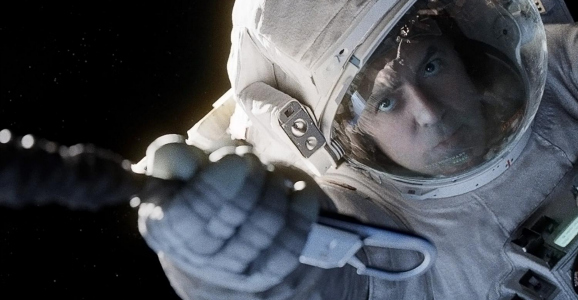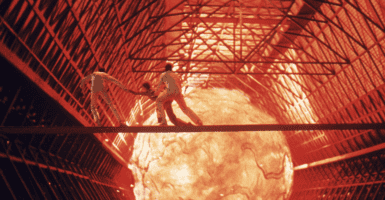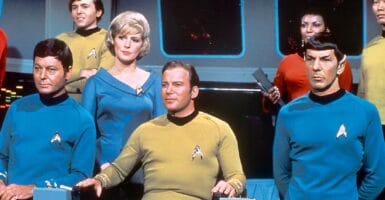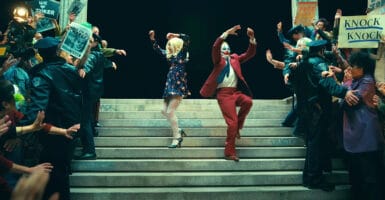Alfonso Cuarón Talks Gravity’s Visual Metaphors, And George Clooney Clarifies His Writing Credit
This article is more than 2 years old
 Now that Alfonso Cuarón’s Gravity is in theaters, the space epic is quickly marching toward a $100 million worldwide box office after breaking records in its opening weekend. While the film is a non-stop thrill ride, some criticized the film for not being more than a fun movie. Yes, Alfonso Cuarón packed the film with excitement, but he also packed the film with visual metaphors and ideas.
Now that Alfonso Cuarón’s Gravity is in theaters, the space epic is quickly marching toward a $100 million worldwide box office after breaking records in its opening weekend. While the film is a non-stop thrill ride, some criticized the film for not being more than a fun movie. Yes, Alfonso Cuarón packed the film with excitement, but he also packed the film with visual metaphors and ideas.
SPOILERS BELOW!
If you’ve seen the film, one of the most memorable shots is of Sandra Bullock’s Dr. Ryan Stone in the International Space Station, curled up in the fetal position with a tube from her suit doubling as a symbolic umbilical cord. The shot is well composed and striking, and Cuarón meant the film to be about re-birth as Dr. Stone comes to terms with her life, while she strives for survival.
In an interview with io9, Cuarón speaks about the deeper meaning of Gravity and how the film is full of visual metaphors and symbolism. He begins to talk about the connection between humanity and the Earth. Once that connection is severed, Dr. Stone’s journey begins. He describes space as the best way for the character to get out of her bubble and find footing on Earth and with herself. Cuarón says:
Space already lends itself to all these metaphorical possibilities. I think rebirth in many ways is part of the journey for everybody, not only every human in Earth, but it’s also the journey of great characters. Great characters in literature or in cinema they go through the stages of rebirth and of a new understanding.
Cuarón also points out that drifting in space is a metaphor for Dr. Stone’s drifting through life after the death of her daughter. Her journey back to Earth is her coming to terms with the past and moving on. The film ends with Dr. Stone emerging from the ocean, only to find footing on solid ground. Cuarón adds:
She’s in these murky waters almost like an amniotic fluid or a primordial soup. In which you see amphibians swimming. She crawls out of the water, not unlike early creatures in evolution. And then she goes on all fours. And after going on all fours she’s a bit curved until she is completely erect. It was the evolution of life in one, quick shot.
One of my main criticisms of Gravity is that the story is very broad and not very deep. While Cuarón’s approach to Gravity is very much in the film, I still feel Gravity is operating on a very surface level. Aside from some brilliant photography and thrills, the film boils down to a survival story full of exciting set pieces. It doesn’t convey anything more than that to my satisfaction, namely due to Cuarón being more interested in giving audiences action rather than showing off the process for Dr. Stone’s survival. Instead we get an almost live-action version of the climax of Pixar’s Wall-E. I agree that the film is about rebirth, but it’s the most obvious and heavy-handed portrait of a character coming to terms with their past. It’s not as profound as Alfonso Cuarón leads on.
Meanwhile, George Clooney clarified that he didn’t actually write one of the key scenes in Gravity. According to Cuarón, the scene where Dr. Stone gives up on life and envisions Clooney’s Matt Kowalski helping her regain her will to live came from the mind of George Clooney himself. Apparently Cuarón and his son Jonás were having trouble with the scene, but Clooney stepped in to fix it.
In an interview with The Wrap, Clooney says it was all a misunderstanding. He didn’t write the scene, but pitched some ideas to make the scene, which was in the script, come together better. Clooney explains:
“Alfonso’s such a sweet guy. He hands out credit to everyone all the time. I said, ‘You guys are struggling, here’s an idea.’ So I wrote out a scene, and there’s a portion of it in the movie about Sandy wanting to live. They were struggling with how to tell people she wants to live, and I said, ‘Maybe you say she talks to her little girl and says Mommy loves her.’ I sent him the scene as I was leaving out of London — I said, ‘Maybe this helps. Maybe this will fix the problem.’ Alfonso said they shot a version of it. I would never write myself a scene to come back in.”
Aside from being really handsome and a good actor and director, George Clooney is also a screenwriter, taking co-writing credits on Good Night, and Good Luck, Leatherheads, and The Ides of March. It’s easy to see why so many ran with Cuarón’s praise of the 52-year-old actor. I’m inclined to believe George Clooney though; Alfonso Cuarón seems to be a very modest director.












